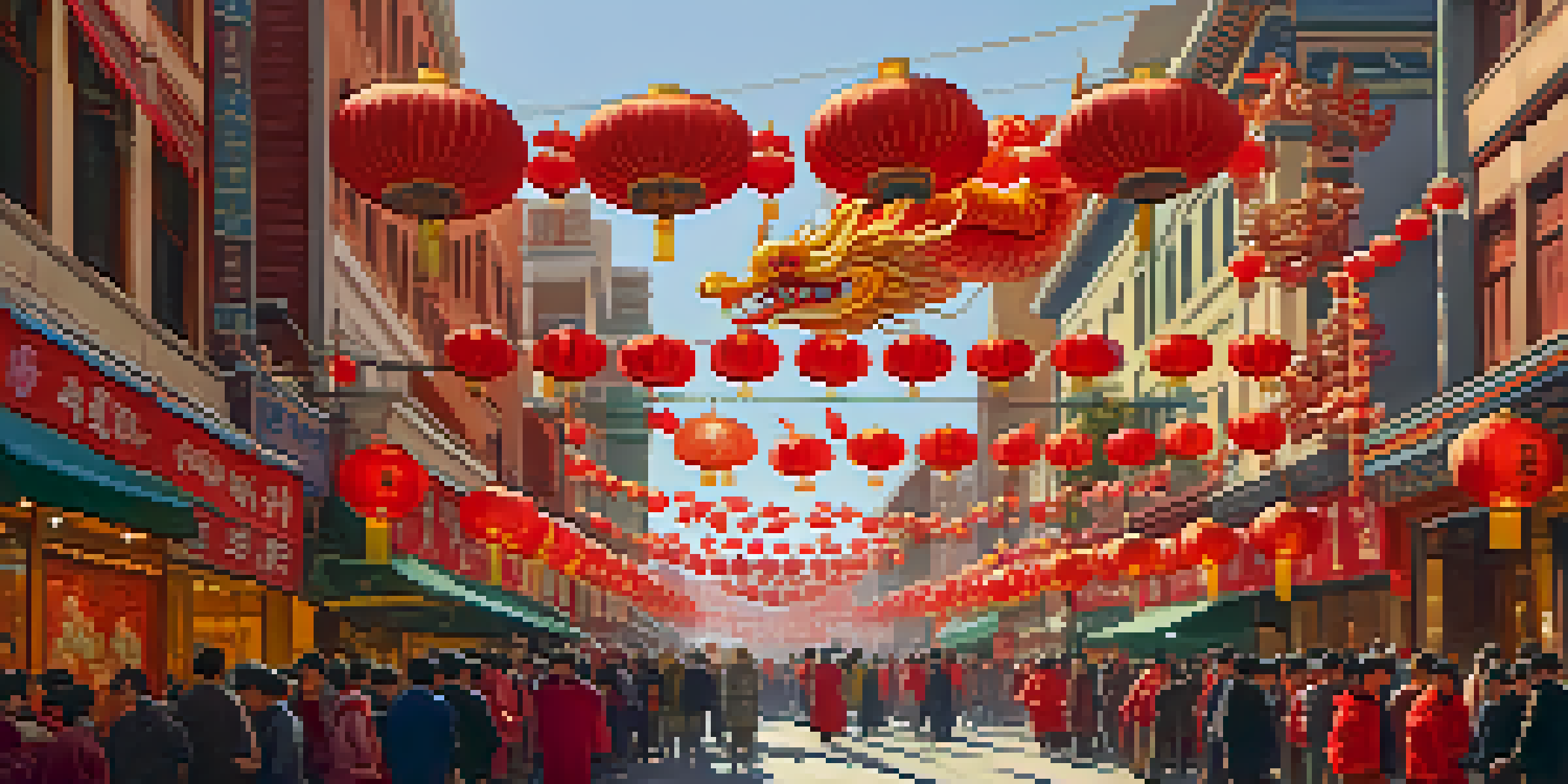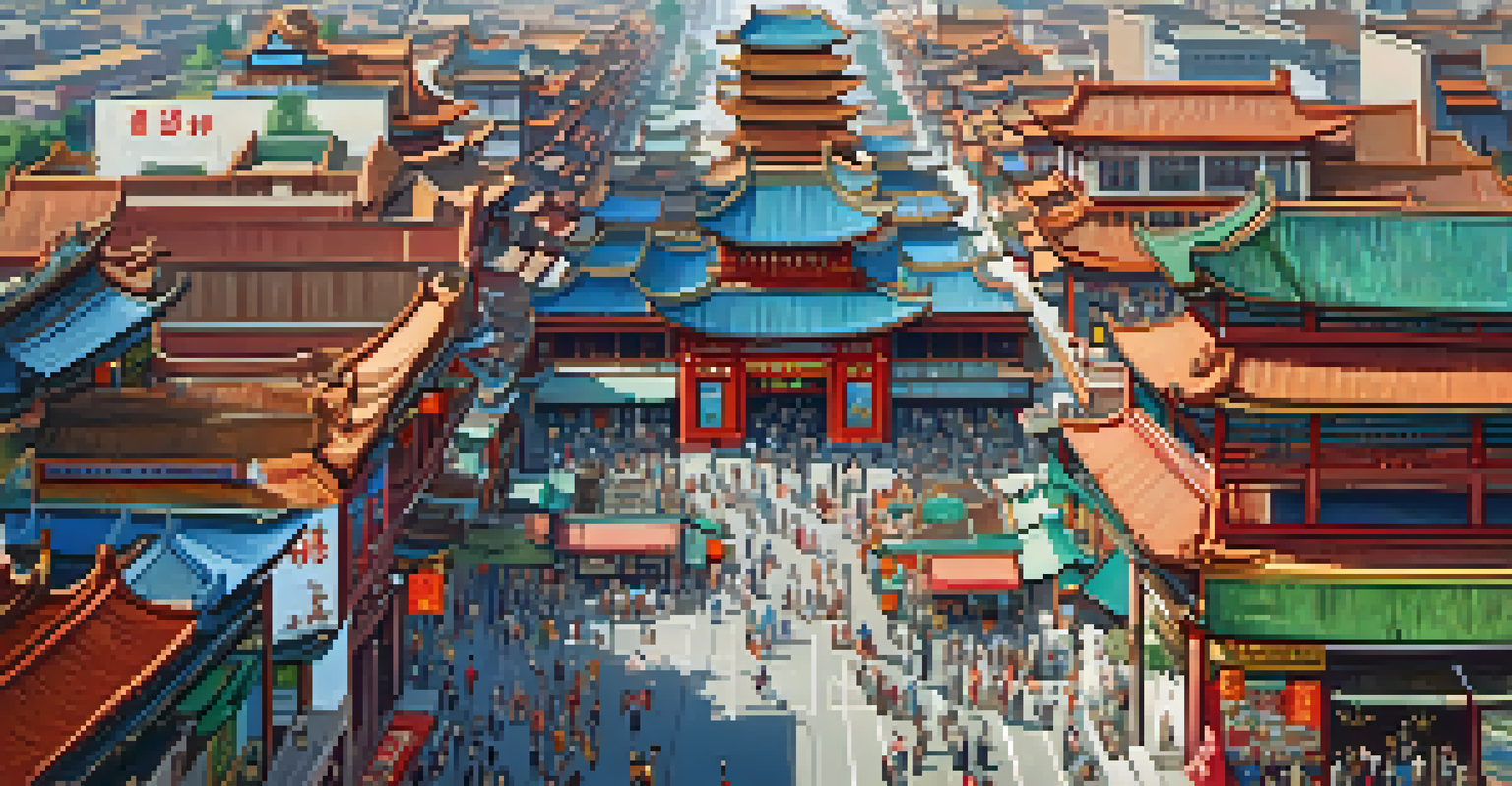The Rise of Chinatown: A Cultural Hub in San Francisco

Chinatown's Historical Roots in San Francisco
San Francisco's Chinatown stands as a testament to the city's rich history, dating back to the mid-19th century. Established in 1848, it was one of the first significant Chinese settlements in the United States, emerging during the Gold Rush. This influx of Chinese immigrants, seeking fortune and opportunity, laid the groundwork for a vibrant community that would flourish despite adversity.
Chinatown is a place where you can experience the past and present of the Chinese American community, and its resilience is a testament to the strength of cultural identity.
The early days were marked by significant challenges, including racial discrimination and exclusion laws. However, the resilience of the Chinese community led to the establishment of businesses, social clubs, and cultural organizations that provided support and solidarity. Over the years, Chinatown evolved into a bustling neighborhood that attracted visitors and locals alike.
Today, Chinatown is not just a historical site but a living, breathing cultural hub. It serves as a reminder of the struggles and triumphs of the Chinese American community, showcasing their contributions to San Francisco's identity.
The Cultural Melting Pot of Chinatown
Chinatown is often described as a cultural melting pot, where diverse traditions and practices coexist harmoniously. Visitors can experience a rich tapestry of Chinese culture through art, festivals, and cuisine. From the vibrant red lanterns that adorn the streets to the intricate lion dances performed during celebrations, every corner tells a story.

Food is a significant part of this cultural experience, with restaurants offering authentic dishes from various regions of China. Dim sum, Peking duck, and hand-pulled noodles are just a few of the culinary delights that draw food lovers to Chinatown. The flavors and aromas create an inviting atmosphere that beckons exploration.
Chinatown's Rich Cultural Heritage
Chinatown is a vibrant cultural hub that showcases the resilience and contributions of the Chinese American community throughout history.
Moreover, the annual events like the Chinese New Year Parade highlight the unity and pride of the community. Such festivals not only celebrate cultural heritage but also invite people from different backgrounds to join in the festivities, reinforcing Chinatown's role as a hub of cultural exchange.
Architectural Wonders: A Visual Feast
One of the most striking features of Chinatown is its unique architecture, which blends traditional Chinese elements with Western influences. The iconic Dragon Gate serves as the main entrance, symbolizing the rich heritage and welcoming spirit of the neighborhood. The vibrant buildings, adorned with ornate details and colorful signage, create a visual feast for visitors.
In the face of challenges, the heart of Chinatown beats stronger, showcasing the power of community and the importance of preserving our cultural heritage.
Walking through the streets of Chinatown, you'll notice the intricate carvings and decorative motifs that reflect Chinese culture and beliefs. Buildings like the Chinese Historical Society of America and the Tin How Temple offer glimpses into the community's past and present. These architectural gems not only enhance the neighborhood's aesthetics but also serve as reminders of its historical significance.
The preservation of these structures is crucial in maintaining the cultural identity of Chinatown. Efforts to restore and protect these sites ensure that future generations can appreciate the beauty and history embedded in the neighborhood's architecture.
Art and Expression in Chinatown
Chinatown is a canvas for artistic expression, showcasing the creativity of local artists. Murals, sculptures, and installations often depict themes of cultural identity, history, and community. These artworks not only beautify the streets but also serve as powerful narratives that reflect the experiences of the Chinese American community.
Art galleries and cultural centers, such as the Chinese Culture Center, provide platforms for artists to share their work and stories. These spaces foster dialogue and understanding, allowing both residents and visitors to engage with the art and the artists behind it. They also promote cultural events, workshops, and exhibitions that highlight the richness of Chinese artistic traditions.
Economic Vitality of Chinatown
As a major tourist destination, Chinatown significantly contributes to San Francisco's economy through local businesses and job creation.
Through art, Chinatown becomes a place where history and contemporary issues intersect. It invites reflection and conversation, making the neighborhood a vibrant space for cultural exchange and understanding.
Chinatown's Economic Impact on San Francisco
The economic significance of Chinatown extends beyond its cultural offerings; it plays a vital role in San Francisco's economy. As a major tourist destination, it attracts millions of visitors each year, contributing to local businesses and the hospitality industry. This influx of tourists supports restaurants, shops, and markets, creating jobs and driving economic growth.
Small businesses thrive in Chinatown, often family-owned and operated, reflecting the entrepreneurial spirit of the community. These establishments not only provide unique products and services but also foster a sense of community and belonging. The preservation of these businesses is essential for maintaining the neighborhood's character and charm.
Furthermore, Chinatown's economic impact resonates throughout the city, influencing various sectors and contributing to its overall vibrancy. As the neighborhood continues to evolve, its economic contributions remain a crucial aspect of San Francisco's dynamic landscape.
Challenges Facing Chinatown Today
Despite its rich history and cultural significance, Chinatown faces several challenges in the modern era. Gentrification poses a significant threat, as rising property values and rents drive out long-standing residents and businesses. This shift not only alters the neighborhood's character but also endangers its cultural heritage.
Additionally, issues such as the COVID-19 pandemic have disproportionately affected small businesses in Chinatown. Many establishments struggled to survive during lockdowns, leading to closures and a decline in foot traffic. The community's resilience is being tested as it navigates these turbulent times.
Challenges and Community Resilience
Despite facing modern challenges like gentrification and the pandemic, the community remains resilient, working to preserve its cultural identity.
However, efforts to support local businesses and preserve the community's cultural identity are underway. Initiatives aimed at revitalizing Chinatown and promoting its unique offerings are crucial in ensuring that this vibrant neighborhood continues to thrive for generations to come.
Community Resilience and Empowerment
The strength of Chinatown lies in its community, which has demonstrated remarkable resilience over the years. Local organizations and grassroots movements have emerged to advocate for the needs and rights of residents and businesses. These initiatives aim to uplift the community and preserve its cultural identity amid challenges.
Community events, educational programs, and workshops play a vital role in fostering unity and empowerment. They provide opportunities for residents to connect, share experiences, and celebrate their heritage. This sense of belonging is crucial in combating the challenges posed by gentrification and economic uncertainty.

Moreover, the community's collective efforts to support one another have become a model for resilience. By working together, residents are not only preserving their history but also shaping a brighter future for Chinatown, ensuring its continued significance in San Francisco.
The Future of Chinatown: A Cultural Beacon
As we look to the future, Chinatown remains a cultural beacon in San Francisco, embodying the spirit of diversity and resilience. The ongoing efforts to preserve its unique character while adapting to modern challenges are crucial for its sustainability. Community engagement and support for local businesses will play a pivotal role in this journey.
Chinatown's ability to evolve while honoring its rich heritage will define its future. Continued cultural celebrations, artistic expressions, and economic initiatives will ensure that this vibrant neighborhood thrives. It will remain a place where traditions are celebrated, stories are shared, and connections are forged.
Ultimately, Chinatown stands as a symbol of hope and perseverance, reminding us of the importance of cultural identity and community in an ever-changing world. As we embrace the future, we must cherish and support Chinatown as a vital part of San Francisco's cultural landscape.